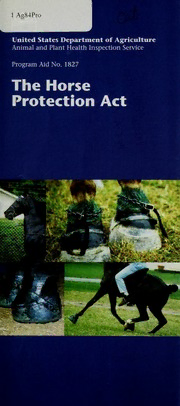
The Horse Protection Act PDF
Preview The Horse Protection Act
Historic, Archive Document Do assume not content reflects current scientific l<nowledge, policies, or practices. Ag84Pro United States Department ofAgriculture Animal and Plant Health Inspection Service Program Aid No. 1827 The Horse Protection Act The U.S. DepartmentofAgriculture's (USDA) Animal and Plant Health Inspection Service (APHIS) enforces the Horse Protection Act (HPA). The HPA is a Federal lawthat prohibits horses that havebeen subjected to a practice called soring from participating in auctions, exhibitions, sales, or shows. The HPA also prohibits drivers from transporting soredhorses to or from any ofthese events. Soring Soring is a cruel and inhumane practice used to accentuate a horse's gait. Soring maybe accomplishedbyirritating orblistering a horse's forelegs through the injection or application of chemicals or mechanical devices that cause irritation. Soring mayalso be accomplishedbythe infliction ofcuts, lacerations, orburns, orbythe engagement ofanypractice that could reasonablybe expected to cause a horse to sufferpain or distress whilewalking, trotting, or otherwise moving. An accentuated gait mayalsobe accomplishedbyusinginhumane hoof Caitalterations createdbysoring tine forelimbs mayresultin abnormalstresses in the hindlegs. Applyingsubstances otherthan mineraloil, glycerin, andpetrolatum, orcombinations thereof, violates the HPA regulations. trimming orpressure-shoeingtechniques. Sored horses sometimes develop permanent scars in the pastern area due to theuse ofthe painful chemicals ordevices involved in the soringprocess. When it walks, a sored horse respondsbyquicklyliftingits frontlegs to relieve pain. In the 1950s, some horse owners andtrainers who wanted to improve theirhorses' chances to win at shows used soringas an unfair shortcutto conventional trainingmethods. Because sored horses gained a competitive edge, the practicebecame popular andwidespreadin the 1960s. Public outcry overthis abusive practice led to the Horse Protection Act, which Congress passed in 1970 and amended in 1976. The HPA is intended to ensure that responsible horse owners and trainers will not suffer as a result ofunfair competition from those who sore their horses and that horses will notbe subjected to the cruel practice ofsoring. Although the HPA covers all horse breeds, Tennesseewalking horses, racking horses, and other high-steppingbreeds are the most frequentvictims ofsoring. Responsibility Responsibilityforpreventing sored horses from being exhibited, shown, or sold rests with owners, riders, sellers, trainers, and managers ofthese events. Owners and trainersbenefit ifa horse wins a show or sells for a high price, thus leadingto greater incentive to sore the horse. Event managers, however, have the majorlegal responsibilityto exclude or disqualify sored horses at their auctions, exhibitions, sales, or shows. Carefulmeasurements aredone to ensure thatmetalhoofbands are in compliance with the regulations. I Designated Qualified Persons To facilitate enforcement ofthe HPA, APHIS established the designated qualified person (DQP) program. DQPs are USDA-accreditedveterinarians with equine experience, or theyare farriers, horse trainers, or other knowledgeable horse peoplewho havebeen formallytrained and licensedbyUSDA- certified horse industryorganizations or associations. I DQPs are hiredbythe managers ofa sale or showto assure that soredhorses are notexhibited oroffered for auction. DQPs are responsible forphysicallyinspectingevery Tennesseewalkinghorse andrackinghorsebefore it j' maybe exhibited, shown, or sold and everyfirst-place horse after it is shown. DQPs mustreportto show management anyhorses that do notmeet Federal regulations underthe HPA. Itis showmanagement's legal responsibilityto disqualifysoredhorses. Monitoring DQPs and Enforcing the HPA APHIS inspectionteams attend some horse events to conductunannouncedinspections. The APHIS inspection team mayincludeveterinarymedical officers (VMOs), animal care inspectors (ACIs), and investigators. The primaryresponsibilityofAPHIS' VMOs is to evaluate the DQPs' inspection procedures. VMOs also observe horses during shows, sales, and exhibitions and mayexamine anyhorse for signs of soring. DQPs mayhave theirlicense canceled iftheir inspection procedures do notmeet HPAstandards. Signs of Soring The examination for soring consists ofthree components: an evaluation ofthe horse's movement; observation ofthe horse's appearance duringthe inspection, and physical examination ofthe horse's forelegs from the knee (carpus) to the hoof. Particular attention is paid to the area ofthe coronetband, the anteriorpastern areas, the "pocket" ofthe posterior pastern area, and the bulb ofthe heel, all ofwhich are typical places for the application ofsoring chemicals. The presence ofabnormal tissue, swelling, pain, abrasions, or oozingofblood or serum may indicate soring. Inspectors also measure for shoeingviolations and lookfortraining devices that are too heavyor improperlyapplied. Heavy, rigid devices striking the pastern and coronetband during exercise can cause soring. Hooves andpads are measured to ensure compliance with regulations addressing heehtoe ratio andartificial toe-length extension. Penalties Criminal orcivil charges canbebrought against violators. Ifconvicted; criminalviolators can spendup to 2years in prison andreceive penalties ofup to $5,000. Civil complaints, imposed through administrative procedures, can resultin disqualifications of 1 ormoreyears andpenalties ofup to $2,000 ormoreperviolation. Disqualified persons mayattendhorse eventsbut onlyas spectators and are notallowedto participate in any othermanner. Additional Information Formore information, pleasevisitthe Internet at this Web address: <www.aphis.usda.gov/ac>, or send and e-mail to [email protected]. You may also contactAC's headquarters office: USDA-APHIS-Animal Care 4700 River Road, Unit 84 MD Riverdale, 20737-1234 Phone: (301) 734-7833 Fax: (301) 734-4978 NATIONAL AGRICULTURAL LIBRARY The U.S. Department ofAgriculture (USDA) prohibits discrimination in all its programs and activities on the basis of race, color, national origin, sex, religion, age, disability, political beliefs, sexual orientation, or marital orfamily status. (Not all prohibited bases apply to all programs.) Persons with disabilities who require alternative meansfor communication of program information (Braille, large print, audiotape, etc.) should contact USDA'sTARGET Center at (202) 720-2600 (voice and TDD). To file a complaint ofdiscrimination, write USDA, Director, Office of Civil Rights, Room 326-W, Whitten Building, 14th and Independence Avenue, SW, Washington, DC 20250-9410 or call (202) 720-5964 (voice and TDD). USDA is an equal opportunity provider and employer. Photo credits: Three copyrighted images used in this leafletwere supplied by Steppin'Out magazine, and APHIS gratefully acknowledges their permission to reprint them here. These photos include the covershotwith the horse's head in profile and the captioned images inside the leafletshowing discolored pasterns and the abnormal gait of a sored horse. Serge Cognard tookthese three images. APHIS veterinarian Todd Behre took the photo with the side view of hooves. APHIS investigator Phillip Ledbettertook the measurement image. Issued June 2005
